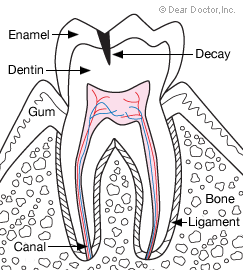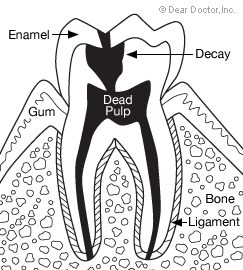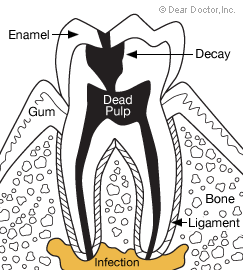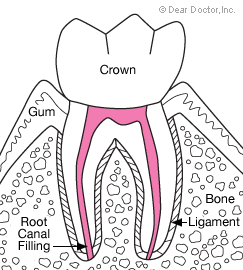I'd Rather Have a Root Canal...
A Popular Expression With A Common Misconception!
(Continued)
|
How Tooth Decay Can Cause A Root Canal |
 |
| Stage 1: A healthy tooth with the start of a small cavity or decay from the developmental groove on the top of the tooth. |
 |
| Stage 2: The progression of the decay contaminating the nerve (pulp) of the tooth causing the nerve tissue to die. |
 |
| Stage 3: As the nerve dies an infection results causing pain and swelling. |
 |
| Stage 4: A completed endodontic filling that seals the tooth and allows it to remain in function for many years. |
The pulp chamber is a complex system of extraordinary microscopic structure consisting of primary canals (trunks) and secondary canals (branches), which might resemble a Christmas tree. Specialized techniques are usually required to seal the fine lateral or accessory canals that offer “collateral” circulation between the pulp and the adjoining tissues. Most endodontists today use operating microscopes to achieve their task of performing excellent root canal treatment.
Effective removal of a diseased pulp and the bacteria associated with it can ensure a lifetime of comfort and function. Interestingly, tooth removal can be as effective in relieving pain as root canal therapy, but tooth loss can lead to other untoward side effects such as unwanted tooth movement or migration of teeth leading to subsequent malocclusion and an inability to chew. Saving your natural teeth should always be your first choice when dental care is needed. Nothing, not even the most advanced bridges or implants, can truly replace your natural teeth. If you are in doubt about saving a tooth with a root canal problem ask your dentist and seek his advice regarding a specialist consultation with an endodontist.
Symptoms that might indicate that you need a root canal treatment include:
- Momentary sensitivity and/or lingering pain after eating hot or cold foods
- Sensitivity to hot or cold foods after dental treatment
- Sharp pain when biting down on food
- Constant and severe pain and pressure
- Swelling of the gingival (gum tissue) and sensitivity to touch
Gum abscesses may also be caused by periodontal disease so that a proper diagnosis is required to ensure that the correct problem is being addressed. It will take an examination by your dentist or endodontist to determine if root canal treatment is indicated.
Low-grade or “chronic” inflammation and infection can persist for extended periods of time and cause other problems. Some of the systemic problems that have been associated with chronically inflamed or infected teeth are endocarditis (infection and inflammation of the heart valves), a predisposition to atherosclerosis and strokes, pneumonia and auto-immune disease. Further, if the problem is diagnosed and treated before acute symptoms develop, there is a much higher rate of success and a minimum of post-operative side effects.
It is normal to feel some tenderness in the area of the root canal treatment for a few days after the procedure as your body undergoes the natural healing process. You may also feel some tenderness in your jaw from keeping it open for an extended period of time. These symptoms are temporary and usually respond very well to over-the-counter pain medications, particularly anti-inflammatory agents such as ibuprofen or naprosyn.
Root canal treatment is only one step in returning your tooth to full function. A proper final restoration or crown on the tooth is extremely important in ensuring long-term success. Contact your dentist within two weeks to arrange your next appointment. If your tooth is being treated in more than one visit by an endodontist, do not return to your dentist for the final restoration until the root canal treatment is completed. Most posterior or back teeth (bicuspid and molars) will require a crown to protect them from further injury such as fractures since endodontically-treated teeth may become more susceptible to fracturing over time.
The tooth that has had appropriate endodontic treatment followed by a proper restoration can last as long as other natural teeth.
The tooth that has had appropriate endodontic treatment followed by a proper restoration can last as long as other natural teeth. After the tooth has been restored, you need only practice good oral hygiene, including brushing, flossing, regular dental check-ups and cleanings. Your dentist or endodontist may periodically x-ray the tooth to ensure that healing has occurred. Occasionally, a tooth that has undergone endodontic treatment does not heal or pain continues. At times, the tooth may become painful or diseased months or even years after successful treatment. Often when this occurs, repeating the endodontic procedure can save the tooth.

